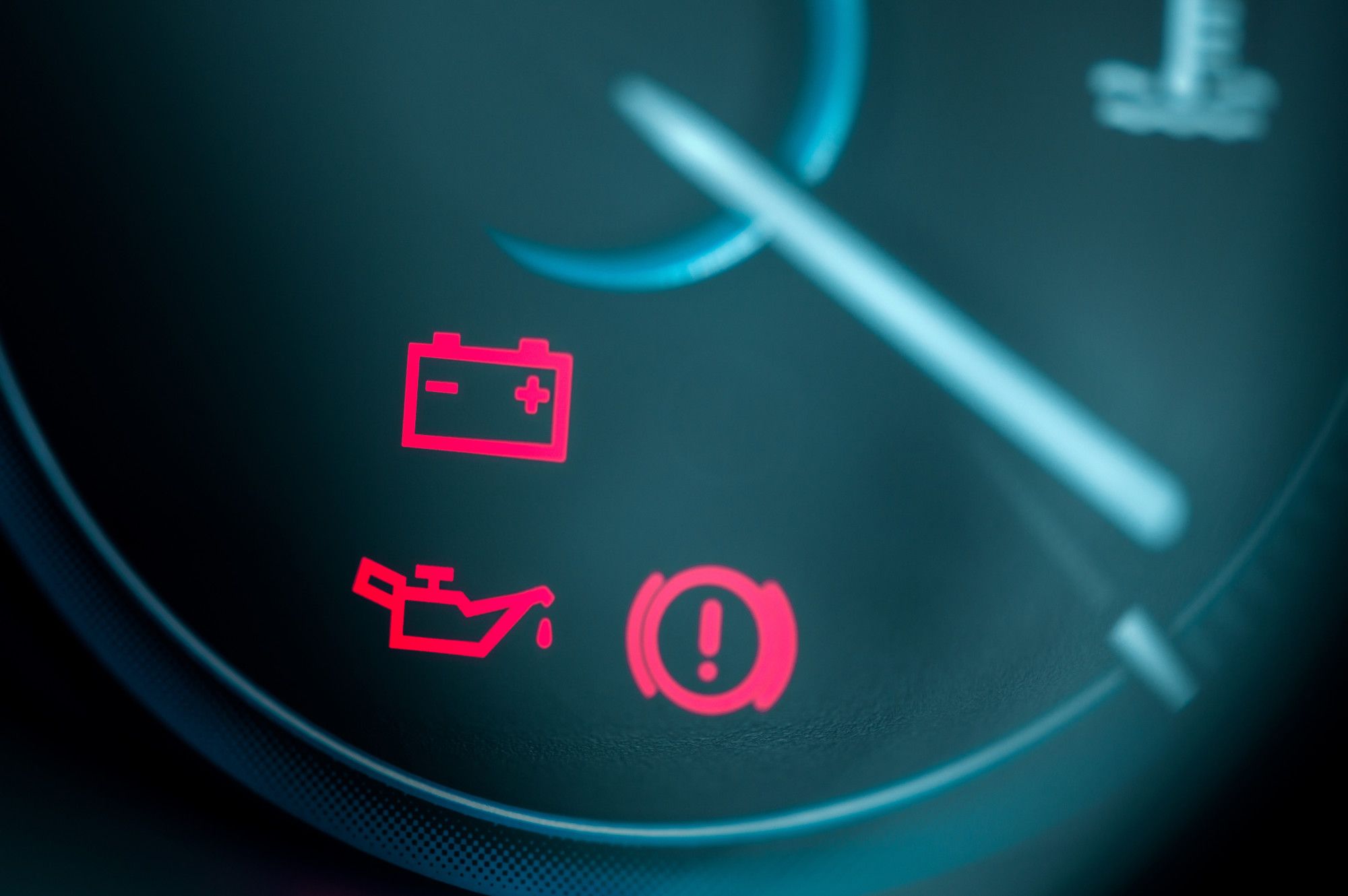We’ve all experienced that dreaded moment — you’re rolling down the road thinking about work or what you’ll have for dinner when suddenly, a sound catches your ear. You turn the radio down and listen to the unmistakable and alarming new noise your car is making. Your heart sinks as you realize something is wrong with your car, and now you have to figure out what it is and how to fix it.
Car problems are annoying, but they are an expected part of owning your own ride. Read on to learn about some of the most common car problems and what you should do when they crop up.
Broken Exterior Lights
One of the most common car problems people run into is having broken or burned-out headlights or taillights. Your car may alert you that you have a bulb out, or you may notice your headlights just aren’t shining as brightly. Some people even get pulled over and informed that the light that illuminates their license tag has burned out.
In general, fixing broken exterior lights is a simple matter of changing the bulb, which you can get at most auto parts stores. You’ll need to read your car’s owner's manual for exact instructions on how to change these bulbs. If you’ve changed the bulb and the light still isn’t working, you may have to replace the entire light assembly itself, which can be more complex and expensive.
Active Warning Lights
Raise your hand if you have a warning light active on your car’s dashboard right now. We’re guessing that about half of you raised your hands and that half of those people have been ignoring this light for three months or longer. Active warning lights are among the most common issues car owners deal with every day.
Your car may have a variety of warning lights to signal you about a number of different problems. You may have lights to warn of low oil, low tire pressure, burned-out lights, overheating, high pressure, and the generic check engine light that means something else is going on. It’s a good idea to get these problems examined and addressed as soon as possible to keep your car in good working order.
Bad Fuel Economy
Fuel efficiency is the measure of how many miles your car can go on a single gallon of gas. Fuel economy varies widely from car to car, and in general, it may get slightly worse over the car’s lifespan. But a sudden drop in your fuel economy could be an indicator that there’s a more serious problem going on.
In general, bad fuel economy is an indicator that your car’s engine isn’t working as efficiently. This could be the result of dirty fuel or air filters, bad mass airflow sensors, bad O2 sensors, and so on. If you notice a serious decline in your fuel efficiency, take your car to a mechanic to figure out what could be causing the problem.
Flat Tires
Flat tires are an unfortunate situation most of us will have to deal with at some point or another. Changing the tire isn’t a huge deal, even if it is inconvenient. But determining the cause of the flat could be more involved and may include buying a new tire, which can get expensive.
The first step when you discover a tire is flat is to get to someplace safe before you work on changing it. If you’re on the highway, get off at the nearest exit and make your way to a safe parking lot, preferably one that’s well-lit. If you’re in public, especially in an unfamiliar area, consider calling the police so an officer can come offer protection and assistance as needed.
Bad Brakes
Bad brakes are one of the most worrying — and common — car problems, especially on cars with a lot of miles on them. Many people may notice that their brakes are squealing or screaming when applied. Oftentimes, this is a sign of worn-out brake pads, which will need replacing.
In some cases, you may notice your brakes feel a little “loose,” or your brake pedal is going down farther than usual. If you see this, take your car to a mechanic or get the parts you need to fix it at once. It could be a sign that your brakes are about to fail, which could cause a dangerous crash.
Poor Alignment
Often, the steering mechanism on your car can start to get a little out of whack as you drive the vehicle. Poor wheel alignment can cause your car to pull to one side or the other, forcing you to tug on the steering wheel to keep it going in a straight line. While this may not seem like a big deal at first, over time, it can cause certain parts of your car to wear out faster.
It’s easy to test the alignment on your car; while you’re driving, look for a long, flat, straight section of road at a time when there isn’t a ton of traffic around. Get your car going straight, and then let the steering wheel go, keeping your hands near the wheel. If your car drifts off to one side or the other, it may be a sign that your alignment needs some attention.
Overheating
Engine overheating is among the more serious of the common car problems. As you probably know, your car engine produces a lot of heat, and it has a complex cooling system in place to keep those temperatures regulated. When one of these engine components breaks down, your car can overheat, which could lead to catastrophic engine failure.
If you notice your car’s temperature gauge is reading higher than normal, pull your car over immediately and turn it off. This overheating may be the result of low oil levels, a bad thermostat, a broken water pump, or a clogged radiator. Staying on top of maintenance is the best way to prevent overheating before it occurs.
Poor Emissions
Depending on where you live, you may need to get your car’s emissions tested on a routine basis. This process is designed to make sure your car isn’t putting too many toxic fumes into the atmosphere. As your vehicle gets older, you may notice the emissions test results are starting to get worse, or your car may not pass these tests at all.
In most cases, emissions test centers will let you know what’s causing the poor emissions so you can have it fixed. The most common culprits are bad O2 sensors or malfunctions in your exhaust system. If you notice your test results are getting worse, it’s a good idea to get your car to a mechanic to diagnose and fix the problem early.
Broken AC or Heat
Few things are more miserable than having a car with a heat or AC system that doesn’t work. As your car gets older, you may notice it has to work harder to keep the interior at a comfortable temperature. While this isn’t likely to cause major malfunctions in your car, it certainly does make it less comfortable.
In some cases, a poorly functioning AC system may be the result of low coolant levels. You may also have broken controls or problems with your compressor. A broken heater could be the result of heater core issues and should be addressed as soon as possible, especially if you live somewhere that gets cold in the winter.
Dead Battery
Next to flat tires and active warning lights, a dead battery may be the single most common car problem. A discharged battery that has run out of charge because of a light being left on is a simple matter to fix. You’ll need to use an external battery or another car’s battery to jump-start your car and then allow the motor to run long enough for the alternator to recharge the battery.
However, you may start to notice that your battery is dying more and more frequently. Batteries wear out over time, and you’ll need to replace your car battery every four or five years. Many auto parts stores offer free battery testing so you can see if it’s time to replace the battery.
Fix Common Car Problems
If you own a car, sooner or later, you’re going to run into one of the problems we’ve discussed here. From flat tires and dead batteries to overheating engines, most of these problems are fairly routine and can be easily fixed. The best way to prevent these problems before they start is to perform regular maintenance on your car. If you’d like to learn more about common car problems, check out the rest of our site at StockWise Auto. Our mission is to simplify the auto parts shopping experience with an easy-to-use catalog and spectacular in-house customer service. Dive into our comprehensive, industry-standard parts catalog and find exactly what you need for your next repair!





































